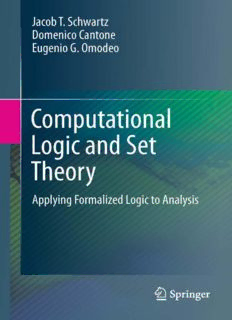Table Of ContentComputational Logic and Set Theory
Jacob T. Schwartz (cid:2) Domenico Cantone (cid:2)
Eugenio G. Omodeo
Computational
Logic and Set
Theory
Applying Formalized Logic to Analysis
Foreword by Martin Davis
Prof.Dr.JacobT.Schwartz Prof.EugenioG.Omodeo
(January9,1930–March2,2009) Dept.ofMathematics&ComputerScience
NewYorkUniversity UniversityofTrieste
NewYork,NY ViaValerio12/1
USA 34127Trieste,
Italy
Prof.DomenicoCantone
[email protected]
Dept.ofMathematics&ComputerScience
UniversityofCatania
VialeAndreaDoria6
95125Catania
Italy
[email protected]
ISBN978-0-85729-807-2 e-ISBN978-0-85729-808-9
DOI10.1007/978-0-85729-808-9
SpringerLondonDordrechtHeidelbergNewYork
BritishLibraryCataloguinginPublicationData
AcataloguerecordforthisbookisavailablefromtheBritishLibrary
LibraryofCongressControlNumber:2011934034
©Springer-VerlagLondonLimited2011
Apartfromanyfairdealingforthepurposesofresearchorprivatestudy,orcriticismorreview,asper-
mittedundertheCopyright,DesignsandPatentsAct1988,thispublicationmayonlybereproduced,
storedortransmitted,inanyformorbyanymeans,withthepriorpermissioninwritingofthepublish-
ers,orinthecaseofreprographicreproductioninaccordancewiththetermsoflicensesissuedbythe
CopyrightLicensingAgency.Enquiriesconcerningreproductionoutsidethosetermsshouldbesentto
thepublishers.
Theuseofregisterednames,trademarks,etc.,inthispublicationdoesnotimply,evenintheabsenceofa
specificstatement,thatsuchnamesareexemptfromtherelevantlawsandregulationsandthereforefree
forgeneraluse.
Thepublishermakesnorepresentation,expressorimplied,withregardtotheaccuracyoftheinformation
containedinthisbookandcannotacceptanylegalresponsibilityorliabilityforanyerrorsoromissions
thatmaybemade.
Coverdesign:VTeXUAB,Lithuania
Printedonacid-freepaper
SpringerispartofSpringerScience+BusinessMedia(www.springer.com)
JacobTheodore“Jack”Schwartz(January9,1930–March2,2009),courtesyofDianaRobinson
Schwartz
Foreword
Jack Schwartz, the principal, but alas posthumous, author of this book, turned his
seriousattentiontocomputerscienceinthemid1960s.Atthetimehehadalready
been recognized as a brilliant young mathematician, and the two volumes of the
magisterial Dunford–Schwartz Linear Operators already in print were widely ad-
mired.Jacksawthatcomputersweregoingtohavearevolutionaryeffectandthat
theexpansionsoftheirusewouldgiverisetomanyfundamentalproblems,andhe
wanted to be part of that. He realized that as software became more complex the
questionofhowitscorrectnesscouldbeensuredwouldbecomeevermorecritical.
Moreoverhesawformallogicembodiedincomputerprogramsasanimportantpart
oftheanswer.
AsubstantialpartofJack’sresearchprogramincomputersciencederivedfrom
hisappreciationofthepossibilityofexpressingmathematicaldiscourseinthelan-
guage of set theory. In much the same way that the seventeenth century work of
Descartes and Fermat had shown that propositions of Euclid’s geometry could be
regarded as statements in the language of algebra, so the twentieth century con-
tributionsofRussell,Zermelo,andvonNeumannshowedhowpropositionsofthe
variousbranchesofmathematicscouldberegardedasstatementsinthelanguageof
settheory.Thisappreciationledhiminthreedirections:
1. He designed SETL, a general purpose high level programming language based
onthelanguageofsettheory.Theneedtoachieveacceptableperformancefrom
softwarewritteninalanguagethatmadenoconcessionstothevagariesofcom-
puterarchitectureledtoworkoncompileroptimizationinfruitfulcollaboration
withresearchersfromIBM.
2. After studying Heinrich Behmann’s algorithm for the decision problem of sec-
ondordermonadicpredicatecalculus,Jacksawthatthesemethodscouldbeex-
tendedtoyieldalgorithmsfordecidablefragmentsofsettheory.Overaperiodof
decades,workingwithagroupofcollaboratorsalmostallfromItaly,whowere
firststudentsatNewYorkUniversityandthenbecamedistinguishedscientistsin
theirownright,asurprisingcollectionofnon-trivialmathematicswasfoundto
liewithinthescopeofsuchalgorithms.
vii
viii Foreword
3. WorkingwithsomeofthesesameItalianresearchers,acomputerprogramwas
designed and implemented (at least as a prototype) that could verify the cor-
rectness of mathematical proofs presented in the language of set theory. Jack
proposedtousethisverifiertocertifythecorrectnessofasubstantialbodyofthe
fundamentalsofmathematicalanalysis.Thiswastoincludeproofsofthebasic
propertiesoftherealandcomplexnumbersystemsdefinedinset-theoreticterms,
thefundamentalpropertiesoflimits,continuityandthedifferentialandintegral
calculus, and was to culminate in a proof of the Cauchy Integral Theorem of
complexanalysis.
Thepresentvolumeisconcernedwiththisverifier,itsuseanditscontext.How-
everthiscontextistobeunderstoodinanextremelybroadsense.Someofthework
on decidable fragments of set theory is presented in a context that includes other
algorithmsfromvarioussourcesforbranchesoflogicaswell.Themainmetamath-
ematicaltheoremscoveredinamoderncourseinmathematicallogicarehere:the
completenesstheoremandthetwoincompletenesstheoremsofGödel.Suchtopics
asreflectionprinciplesandlargecardinalsarehereaswell.ThosefamiliarwithJack
Schwartz’s mode of thought and with his way of putting his own stamp on a field
willhavenotroublehearinghisvoiceinthisimportantthought-provokingbook.
MartinDavis
ProfessorEmeritus,CourantInstitute,NewYorkUniversity
VisitingScholar,UniversityofCalifornia,Berkeley
Preface
InJune2000,thethirdnamedauthorvisitedNewYorkUniversityandwasinvited
byJackSchwartztoreadwhathecalledthe(“commonshared”)scenario:awide,
carefully assembled sequence of definitions, theorems, and proofs, leading from
thebarerudimentsofsettheorytothebeginningofmathematicalanalysis.Proofs
begantobegappyafterafewhundredpages,andthentotallyabsent,buttheflow
ofdefinitionsandtheoremswenton,toculminateinthedefinitionofcomplexline
integralandfinallyinthecelebratedCauchyintegraltheoremofcomplexanalysis.
Withanimplementationappearingallbutimminent,Jackhadcastasignificant
piece of mathematics in rigorous formal detail, honestly asking himself whether a
computer program could conceivably process and validate every single step. The
resultinglarge-scaleproofscenariowasmeant—inJack’sownwords—“toserveas
an essential part of the feasibility study that must precede the developmentof any
ambitiousproof-checker”.Eventually,itwouldalsoserveasatesting-benchforthe
concreteimplementationoftheproof-checker.
Theconceptionofthisbookoncomputationallogicbeganthen.Accordingtoour
initialplans,thebookwouldhavedescribedthestructureofaproofverifierrooted
insettheoryandwouldalsohavesurveyedatwenty-yearlongstreamofresultson
decidablefragmentsofsettheory.
Oneyearlater,thesecondnamedauthorvisitedNewYorkinhisturn;athisre-
questJackadvancedtheimplementationwork,speedilybringingintoexistencethe
proof-checker Referee, also known as Ref, or as ÆtnaNova. This is still a proto-
type, but it is reliable and fast enough to give us the possibility of debugging our
proofscenarios.Some,thoughnotall,ofthecontentofthisbookisthusrelatedto
concreteexperience,whichwearenowpleasedtosharewithourreaders.
AverylargeproofscenarioisavailabletodayasaLATEX-generatedPDF-file.But
givenitssize(overathousandpages),itseemsappropriatetopublishitontheweb
(andeventuallyasaCD)ratherthantoprintit.Asfortheproofverifier,itisusable
ontheweb,butitdependsonaSETL2implementation.Sincethereishardlyanyone
maintainingtheSETLsystemtoday,Jackundertookwithusare-implementationof
theproofverifierinacurrentlymorepopularlanguage.Butthiswilltakesometime;
itshouldnotbepermittedtodelaythepublicationofthisbook.
ix
Description:As computer software becomes more complex, the question of how its correctness can be assured grows ever more critical. Formal logic embodied in computer programs is an important part of the answer to this problem.This must-read text presents the pioneering work of the late Professor Jacob (Jack) T.

